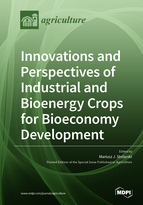Innovations and Perspectives of Industrial and Bioenergy Crops for Bioeconomy Development
A special issue of Agriculture (ISSN 2077-0472). This special issue belongs to the section "Crop Production".
Deadline for manuscript submissions: closed (20 December 2020) | Viewed by 73108
Special Issue Editor
Interests: industrial and energy crops; biomass and byproducts; energy and economic efficiency; biomass production, harvesting, and logistics; multipurpose biomass utilization; bioproducts; biofuels; bioeconomy
Special Issues, Collections and Topics in MDPI journals
Special Issue Information
Dear Colleagues,
The production of industrial and bioenergy crops has been the subject of scientific research for many years; however, the implementation of previously proposed solutions for commercial production is still at an early stage. It should be emphasized that when developing the production of industrial and bioenergy crops on agricultural lands, it is important to avoid land-use competition with the production of food and feed. It is well justified, for initiating the sustainable production of industrial and bioenergy crops, to promote efficient species for growing on marginal lands, which are unsuitable or less suitable for food or feed production. Another important point is that industrial and bioenergy crops should include nonfood and nonfeed crops and generate agricultural products categorized as commodities and/or raw materials for industrial goods and bioenergy. Therefore, this Special Issue will be focused on the following groups of crops: short rotation coppice (willow, poplar, robinia, eucalyptus, etc.), grasses (miscanthus, giant reed, switchgrass, reed canary grass, etc.), herbaceous crops (Virginia mallow, Jerusalem artichoke, etc.); fibre crops (hemp, etc.), oil crops (camelina, crambe, castor, cardoon, etc.), and other alternative crops and their residues that are suitable for the industry or energy sectors.
These industrial and bioenergy crops can become an important source of biomass. Of course, the concept of their cultivation for nonfood (and/or nonfeed) uses is not new but, despite considerable investment in research and development, little progress has been made with regard to the introduction of such crops and their products into the market. Therefore, papers should be focused on innovations and perspectives regarding sustainable industrial and bioenergy crops production, logistic chains, biomass quality, utilization and cascade biomass use for bioeconomy, socio-economic and energy analyses, etc.
I would like to encourage you to publish papers you might think match these topics in this open-access journal Agriculture. Your original research and review papers regarding recent developments and ideas on the abovementioned topics are very welcome.
Prof. Dr. Mariusz J. Stolarski
Guest Editor
Manuscript Submission Information
Manuscripts should be submitted online at www.mdpi.com by registering and logging in to this website. Once you are registered, click here to go to the submission form. Manuscripts can be submitted until the deadline. All submissions that pass pre-check are peer-reviewed. Accepted papers will be published continuously in the journal (as soon as accepted) and will be listed together on the special issue website. Research articles, review articles as well as short communications are invited. For planned papers, a title and short abstract (about 100 words) can be sent to the Editorial Office for announcement on this website.
Submitted manuscripts should not have been published previously, nor be under consideration for publication elsewhere (except conference proceedings papers). All manuscripts are thoroughly refereed through a single-blind peer-review process. A guide for authors and other relevant information for submission of manuscripts is available on the Instructions for Authors page. Agriculture is an international peer-reviewed open access monthly journal published by MDPI.
Please visit the Instructions for Authors page before submitting a manuscript. The Article Processing Charge (APC) for publication in this open access journal is 2600 CHF (Swiss Francs). Submitted papers should be well formatted and use good English. Authors may use MDPI's English editing service prior to publication or during author revisions.
Keywords
- industrial crops
- energy crops
- oil crops
- lignocellulosic crops
- short rotation coppice
- fibre crops
- herbaceous crops
- grasses
- medicinal crops
- alternative crops
- marginal land
- sustainable cultivation
- harvesting and logistic
- crop productivity
- cost and energy analysis
- biomass quality
- cascade biomass utilization
- bioproducts
- solid-liquid-gaseous biofuels






